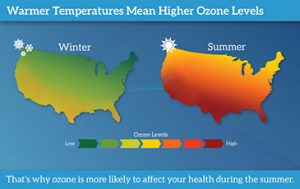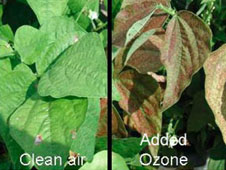Do you like to breathe? I hope so, because it’s an involuntary action that keeps us alive. Of the air I can breathe, clean air is my favorite.
Polluted air is not clean air. Not only is it not fun to breathe (think of car exhaust), but it’s detrimental to your health. There are different kinds of pollutants that can affect air quality, and one of the worst is surface ozone. This is not to be confused with the good ozone that reflects the sun’s rays. Surface or ground-level ozone is bad ozone.

Why should we care about how much surface ozone is in the atmosphere? Well, studies show a positive relationship between surface ozone levels and temperature, as shown in Figure 1. As temperatures rise, so do surface ozone levels. So, surface ozone levels are likely to increase in the future as climate change worsens, resulting in large numbers of premature deaths and economic losses.
Negative Health Effects of Surface Ozone
Breathing in surface ozone can lead to a variety of health problems, including:
- decreased lung function
- increased chance of infections
- increased chest pain, coughing, and throat irritation
- increased chance of heart attack
- increased respiratory issues (such as asthma attacks)
- death (if exposed long enough)
The risks associated with surface ozone increase for the young, the elderly, individuals with asthma, and individuals who are active outdoors. This means that they are more susceptible to the negative health effects associated with exposure to surface ozone.
The young are more susceptible because their lungs are still developing. The elderly are more susceptible because their lungs are deteriorating. Individuals with asthma are more susceptible because they already have lung and respiratory issues, and air pollution makes this worse. Finally, individuals who are active outdoors, like workers and athletes, are more susceptible simply because they are exposed to surface ozone more often than others.
However, just because you are not part of the susceptible group doesn’t mean that you can’t be affected by surface ozone. The negative effects just appear more easily and are worse in these people.
Where Does It Come From?
Why is ozone on the surface where we can breathe it? Where does it originate?
Surface ozone comes from chemical reactions between nitrogen oxides (NOx) and volatile organic compounds (VOCs) in the presence of heat. NOx and VOCs are emitted from places like industrial facilities, electric utilities, and from vehicle tailpipes, to name a few. So, when it’s hot outside and these factories are running, the potential for surface ozone to arise increases.
This is why ozone alerts typically occur during the summer when it’s really hot outside. On really hot, still summer days, your local weather channel may issue an ozone alert, which means that the potential for surface ozone to form is especially high that day. On days like these, those most susceptible to surface ozone pollution are especially advised to stay indoors and not work outside.
What Can We Do?
Is there anything we can do to decrease the potential for surface ozone to form?
We can refrain from driving our vehicles as much as possible on days when ozone alerts are issued. We can use more environmentally friendly electric appliances, or try to conserve electricity whenever and wherever we can. These options aren’t the only things we can do. AirNow presents more ways you can help reduce surface ozone.
BONUS: in addition to these changes being better for our health, they’re also better for the environment. Surface ozone decreases a plant’s ability to photosynthesize, which is how it survives. Decreasing surface ozone thus helps prevent this from occurring, allowing the plant to photosynthesize and grow to its fullest potential.

Figure 2 shows the effects of surface ozone on plants. The left picture shows a plant without exposure to surface ozone, and the right shows a plant after being exposed to surface ozone. This is what plants look like after being exposed to surface ozone.
What do our lungs look like after being exposed to surface ozone?
Surface ozone is harmful to humans and counterproductive to our ability to breathe properly. No one likes to shower in dirty water because it fails to clean us properly. Breathing in polluted air fails in the same way. Do you want to breathe it in?
